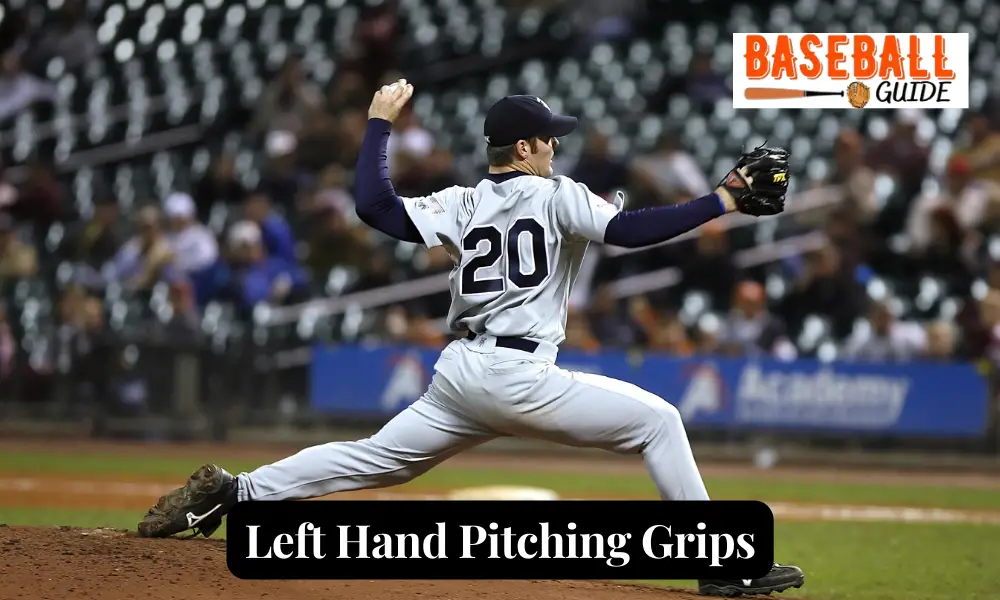For proper pitching, the right grip of the ball is a must to be a good baseball pitcher. While most pitchers are right-handed, there are left-handed specialists who are unique in their pitching grips.
They are considered as an advantage since most batters see a lot more right-handed pitches so a left-handed pitch may be difficult for them to read. This article is about different grips only a left-handed pitcher can use.
Left-Handed Pitches vs. Right-Handed Pitches
Left-handed Pitch
You must have often heard the term LOOGY in baseball. Ever wondered what it means? LOOGY is the short form of Lefty One-Out Guy. This was a term coined by John Sickels, an American Baseball writer.
LOOGY refers to left-handed specialists. There are several left-handed pitchers in Major League Baseball(MLB) on their rosters, at least one of them is a LOOGY.
Left-handed specialists specialize in throwing to left-handed batters, weak right-handed batters, and switch hitters who if bat right-handed, bat poorly.
Right-handed pitch
A left-handed batter’s edge can be negated by a right-handed pitcher by throwing a screwball, which breaks in the opposite direction as a curve.
At higher levels of play, some tailing action can be put by many right-handed pitchers on their fastballs, causing them to bend slightly away from lefty hitters.
Righties or right-handed pitchers may also try and hit the outside corner with curveballs, so as to make the left-handed hitter give up on the pitch and make him believe it will be outside the strike zone.
Different Pitching Grips for Left-Handed Pitchers

Be it Warren Spahn, Sandy Koufax, Whitey Ford Lefty Grove, or Lefty Gomez they are all the outstanding left-handed pitchers in the history of baseball.
There is a great advantage of being a left-handed pitcher for most batters, it’s difficult to read left-handed pitchers as they see a lot more deliveries from right-handed pitchers.
To be an exceptional left-handed pitcher, a few of the best left-handed grips should be mastered by the left-handed pitchers.
Four-seam Fastball
It’s the fastest pitch a pitcher can throw. The pitcher’s middle and index finger cover the two seams Holding the ball in his palm, with the palm facing up so that the visible seams form a “C” shape as looked down at the ball the index and middle fingers must be placed on the upper seam so the fingertips overlap the seam a bit.
Now thumb should be placed on the bottom of the ball; it shouldn’t touch any seams. Holding the ball loosely, with the fingertips, and leaving a gap between the palm and the ball, the ball is thrown.
As there is minimal contact between the ball and the hand, the friction is less on release. This allows the ball to go faster.
Two-seam fastball
The ball is turned 90 degrees in this grip from the four-seam grip. Holding the ball in the palm, this time the seams must resemble a horseshoe with the open end pointed up.
Placing the index and middle fingers along the seams on top of the ball whereas the thumb must be placed just below the bottom end of the horseshoe shape.
The upper part of your thumb should be kept on the ball’s cover, not on a seam. The index should rest the back of the ball and middle fingers, which will cause some friction on release which slows the ball down a bit, relative to the four-seam fastball, and may cause the ball to break a bit to the left of the pitcher before it reaches the plate.
Curve Ball
Talk about hitting difficult pitches, the left-handed curveball is one of them, especially if it breaks sharply. This pitch is rarely seen by hitters and reading it is difficult.
The middle finger should be placed on the outside seam which is closest to the small finger. The forefinger of the pitcher should be right next to the middle finger.
When this pitch is thrown, the wrist is turned forcefully to the left. When the delivery is finished, the fingers will be closest to the ground and the thumb will be pointing to the sky.
Changeup
A change of pace pitch is also known as the changeup which is designed to deceive hitters as it is thrown with the standard fastball motion but still the travel speed of the ball is slower, because of the way it is gripped.
The ball should be placed in the palm with the seams facing the pitcher forming a “C.” Now wrapping the three middle fingers over the top seam, with each fingertip overlapping the seam slightly, the pitcher should position the thumb and the smallest finger on the bottom of the ball, between the seams.
The back of the ball should be rested against the top of the palm so as to maximize the friction and slow the ball down.
Split-Fingered Fastball
If the pitcher has big hands and long fingers, this should be his grip. The pitch is gripped along the seams and the fingers should be spread as wide as they can go.
The thumb should be placed on the bottom of the ball between the two seams. Now the wrist should be snapped downward as the pitch is delivered. A downward movement of the ball is created by the wide placement of the fingers.
Final Words
In conclusion, left-handed pitchers have a variety of pitching grips they can use to throw effective pitches.
The four-seam fastball, two-seam fastball, changeup, curveball, slider, and splitter are all popular pitching grips that lefties can use to keep hitters off-balance and achieve success on the mound.
However, it’s important for lefties to experiment with different grips and find the ones that work best for them based on their individual strengths and weaknesses.
With practice and dedication, left-handed pitchers can become dominant forces on the field and help their teams win games.

